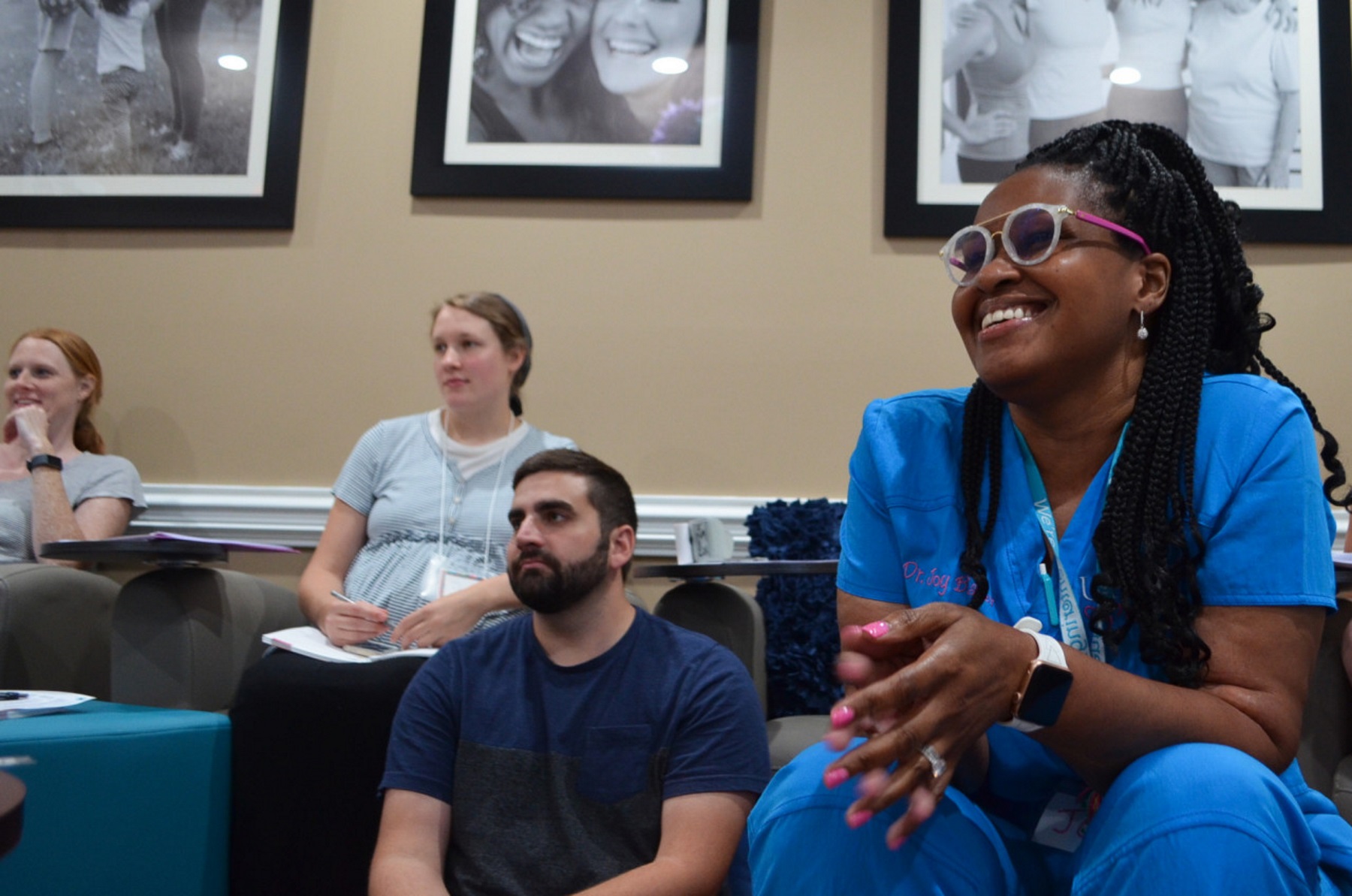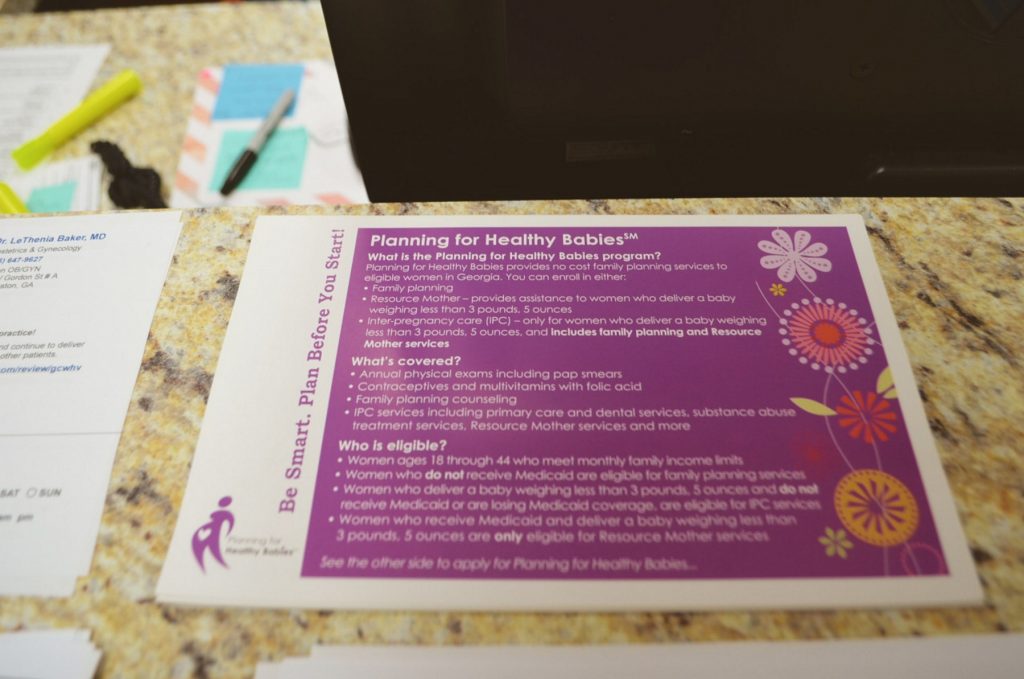Ga. Medicaid Program Isn’t Meeting Its Primary Goal: Reducing Low-Birthweight Births

Dr. Joy Baker listens to a question from an expectant mother in her prenatal care class. She covers many topics in the class: from breastfeeding to postpartum family planning.
Sam Whitehead / WABE
Each week, Dr. Joy Baker’s prenatal care class gathers at her office in Thomaston to discuss a new topic.
On a recent afternoon, they discussed breastfeeding. Baker told her expectant mothers they should do it when and where they need to, even in public.
“Say, ‘Dr. Baker said that I could just get out here and breastfeed,’” she said laughing. “Do it, and let me know!”
In a future class, as her students get closer to giving birth, Baker will talk with them about the importance of postpartum family planning.
She recommends her patients wait at least 18 months between pregnancies. Baker says taking that time can mean healthier moms and babies.
“We want to stop unplanned pregnancies and start moving toward a planned pregnancy [timeline] for these women,” Baker said.
Stopping unintended pregnancies is one goal of a state program called Planning for Healthy Babies (P4HB).

It’s run by the Georgia Department of Community Health and is funded by a Medicaid waiver. Those allow states to tweak how they administer the public insurance program.
P4HB covers contraception for lower income women and other basic health care services for those who’ve had babies weighing less than 3.3 pounds.
The program is intended to solve a pressing public health problem in Georgia.
According to the Centers for Disease Control and Prevention, more low-birthweight babies are born in the state than almost anywhere else in the country.
Those babies are at greater risk for short- and long-term health problems that can dramatically increase state and federal Medicaid costs.
But even though P4HB launched in 2011, it’s faced a series of challenges. First among them: a lack of public awareness of the program.
“I think [the state] has not really done the best job really promoting it,” Baker said. “And making it a core part of our health care system for women who are of childbearing age.”
She says her patients have often never heard of the program. WABE polled the 15 expectant mothers in Baker’s prenatal care class about P4HB, and only three had heard of it.
That lack of awareness is no small problem. It’s one reason why P4HB has failed to meet its primary goal: reducing Georgia’s high rate of low-birthweight births.
According to the latest annual report on P4HB, that number has remained steady for the duration of the program.
“Many times perfection is the worst enemy of good,” said Dr. Alfred W. Brann Jr.
He studies pediatrics at Emory University, and his research on low-birthweight babies inspired P4HB.
Brann says the program has had a number of positive impacts. It’s averted many births in the state by driving down numbers of unintended pregnancies.
Women in the program also waited more time between pregnancies and were older when they had their first child.
Those outcomes translate into real savings for Medicaid, which pays for about half the births in Georgia. P4HB saved Medicaid $23 million in one year alone.

But Brann admit the program could have an even greater impact if more women used its services.
“All of the numbers should be increased, but when there has been no Medicaid expansion, this is one of the significant programs for women who have had high-risk babies,” he said.
Georgia is one of 14 states that did not take the Medicaid expansion that came with Obamacare.
Women in Georgia can qualify for Medicaid while they’re pregnant, but the coverage runs out shortly after they give birth.
P4HB is meant to remedy that.
The state Department of Community Health’s description of the program says it will “fill a critical gap in health care for underinsured and uninsured Georgians.”
But Joan Alker, who studies health policy at Georgetown University, says such programs are only part of a larger health care puzzle.
The coverage they offer is limited and not well-equipped to address the complex health issues that can lead to low-birthweight births.
“Chronic conditions like hypertension, obesity, possibly substance abuse,” Alker explained. “All of these issues need to be addressed early on, and they need to be addressed continuously.”
Georgia Department of Community Health and the contractors that help run P4HB declined to answer WABE’s questions about the program.
But a recent state report outlines a number of ways to improve it, such as more public education and better access to services.
Sitting in her office in Thomaston, Dr. Joy Baker says those things could help.
She also has ideas of her own, such as renaming the program and gathering feedback from the women who actually use it.
“That would kind of help us really be able to get to the meat and potatoes of whether or not this program is doing what it was designed to do initially,” she said.
In the meantime, state officials are seeking federal approval to run the program through 2029. It’s currently set to expire at the end of the month.





